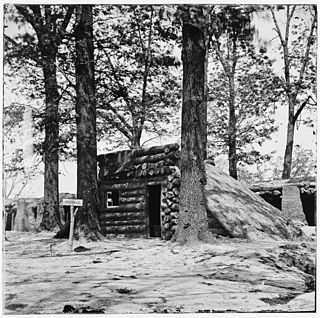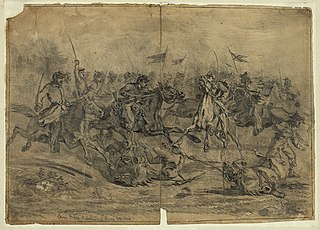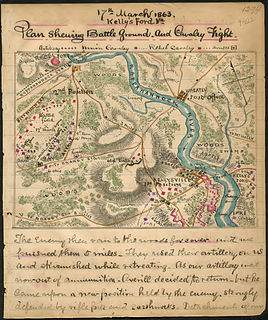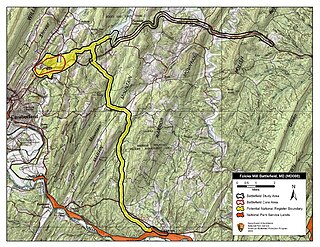
The Battle of New Market was fought on May 15, 1864, in Virginia during the Valley Campaigns of 1864 in the American Civil War. A makeshift Confederate army of 4,100 men defeated the larger Army of the Shenandoah under Major General Franz Sigel, delaying the capture of Staunton by several weeks.

The Battle of Fort Stedman, also known as the Battle of Hare's Hill, was fought on March 25, 1865, during the final weeks of the American Civil War. The Union Army fortification in the siege lines around Petersburg, Virginia, was attacked in a pre-dawn Confederate assault by troops led by Maj. Gen. John B. Gordon. The attack was the last serious attempt by Confederate troops to break the Siege of Petersburg. After an initial success, Gordon's men were driven back by Union troops of the IX Corps commanded by Maj. Gen. John G. Parke.

The Battle of Brandy Station, also called the Battle of Fleetwood Hill, was the largest predominantly cavalry engagement of the American Civil War, as well as the largest ever to take place on American soil. It was fought on June 9, 1863, around Brandy Station, Virginia, at the beginning of the Gettysburg Campaign by the Union cavalry under Maj. Gen. Alfred Pleasonton against Maj. Gen. J.E.B. Stuart's Confederate cavalry.

The Battle of Monocacy was fought on July 9, 1864, approximately 6 miles (9.7 km) from Frederick, Maryland, as part of the Valley Campaigns of 1864 during the American Civil War. Confederate forces under Lt. Gen. Jubal A. Early defeated Union forces under Maj. Gen. Lew Wallace. The battle was part of Early's raid through the Shenandoah Valley and into Maryland in an attempt to divert Union forces away from Gen. Robert E. Lee's army under siege at Petersburg, Virginia.

The Battle of Kelly's Ford, also known as the Battle of Kellysville or Kelleysville, took place on March 17, 1863, in Culpeper County, Virginia, as part of the cavalry operations along the Rappahannock River during the American Civil War. It set the stage for Brandy Station and other cavalry actions of the Gettysburg Campaign that summer. Twenty-one hundred troopers of Brig. Gen. William W. Averell's Union cavalry division crossed the Rappahannock to attack the Confederate cavalry that had been harassing them that winter. Brig. Gen. Fitzhugh Lee counterattacked with a brigade of about 800 men. After achieving a localized success, Union forces withdrew under pressure in late afternoon, without destroying Lee's cavalry.

The Battle of Chaffin's Farm and New Market Heights, also known as Laurel Hill and combats at Forts Harrison, Johnson, and Gilmer, was fought in Virginia on September 29–30, 1864, as part of the siege of Petersburg in the American Civil War.

The Third Battle of Winchester, also known as the Battle of Opequon or Battle of Opequon Creek, was an American Civil War battle fought near Winchester, Virginia, on September 19, 1864. Union Army Major General Philip Sheridan defeated Confederate Army Lieutenant General Jubal Early in one of the largest, bloodiest, and most important battles in the Shenandoah Valley. Among the 5,000 Union casualties were one general killed and three wounded. The casualty rate for the Confederates was high: about 4,000 of 15,500. Two Confederate generals were killed and four were wounded. Participants in the battle included two future presidents of the United States, two future governors of Virginia, a former vice president of the United States, and a colonel whose grandson became a famous general in World War II.
The Valley campaigns of 1864 began as operations initiated by Union Lieutenant General Ulysses S. Grant and resulting battles that took place in the Shenandoah Valley of Virginia during the American Civil War from May to October 1864. Some military historians divide this period into three separate campaigns. This article considers them together, as these campaigns interacted and built upon each other.

The Battle of Folck's Mill, also known as the Battle of Cumberland, was a small cavalry engagement, fought August 1, 1864, in northern Maryland, as part of the Valley Campaigns of 1864 during the American Civil War.

The Battle of Cool Spring, also known as Castleman's Ferry, Island Ford, Parker's Ford, and Snicker's Ferry, was a battle in the American Civil War fought July 17–18, 1864, in Clarke County, Virginia, as part of the Valley Campaigns of 1864. The battle was a Confederate victory.

The Second Battle of Independence was fought on October 22, 1864, near Independence, Missouri, as part of Price's Raid during the American Civil War. In late 1864, Major General Sterling Price of the Confederate States Army led a cavalry force into the state of Missouri in the hopes of creating a popular uprising against Union control, drawing Union Army troops from more important areas, and influencing the 1864 United States presidential election. Price was opposed by a combination of Union Army and Kansas State Militia forces positioned near Kansas City and led by Major General Samuel R. Curtis; Union cavalry under Major General Alfred Pleasonton followed Price from the east, working to catch up to the Confederates from the rear. While moving westwards along the Missouri River, Price's men made contact with Curtis's Union troops at the Little Blue River on October 21. After forcing the Union soldiers to retreat in the Battle of Little Blue River, the Confederates occupied the city of Independence, which was 7 miles (11 km) away.

The Second Battle of Ream's Station was fought during the siege of Petersburg in the American Civil War on August 25, 1864, in Dinwiddie County, Virginia. A Union force under Maj. Gen. Winfield S. Hancock began destroying part of the Petersburg Railroad, which was a vital supply line for Gen. Robert E. Lee's Confederate army in Petersburg, Virginia. Lee sent a force under Lt. Gen. A. P. Hill to challenge Hancock and the Confederates were able to rout the Union troops from their fortifications at Reams Station. However, they lost a key portion of the railroad, causing further logistical difficulties for the remainder of the Richmond-Petersburg Campaign.
The Battle of Jerusalem Plank Road, also known as the First Battle of the Weldon Railroad, was a battle of the American Civil War fought June 21–23, 1864, near Petersburg, Virginia. It was the first of a series of battles during the Siege of Petersburg aimed at extending the Union siege lines to the west and cutting the rail lines supplying Petersburg. Two infantry corps of the Union Army of the Potomac attempted to sever the railroad, but were attacked and driven off by the Confederate Army of Northern Virginia's Third Corps, principally the division of Brig. Gen. William Mahone. The inconclusive battle left the Weldon Railroad temporarily in Confederate hands, but the Union Army began to extend its fortifications to the west, starting to increase the pressure of the siege.

The Battle of Globe Tavern, also known as the Second Battle of the Weldon Railroad, fought August 18–21, 1864, south of Petersburg, Virginia, was the second attempt of the Union Army to sever the Weldon Railroad during the siege of Petersburg of the American Civil War. A Union force under Maj. Gen. Gouverneur K. Warren destroyed miles of track and withstood strong attacks from Confederate troops under Gen. P.G.T. Beauregard and Lt. Gen. A.P. Hill. It was the first Union victory in the Richmond–Petersburg Campaign. It forced the Confederates to carry their supplies 30 miles (48 km) by wagon to bypass the new Union lines that were extended farther to the south and west.

The Battle of Hatcher's Run, also known as Dabney's Mill, Armstrong's Mill, Rowanty Creek, and Vaughn Road, fought February 5–7, 1865, was one in a series of Union offensives during the siege of Petersburg, aimed at cutting off Confederate supply traffic on Boydton Plank Road and the Weldon Railroad west of Petersburg, Virginia.

The Battle of Morton's Ford was a battle of the American Civil War, fought February 6–7, 1864.
The Second Battle of Deep Bottom, also known as Fussell's Mill, New Market Road, Bailey's Creek, Charles City Road, or White's Tavern was fought August 14–20, 1864, at Deep Bottom in Henrico County, Virginia, during the Richmond-Petersburg Campaign of the American Civil War.

The First Battle of Ream's Station was fought on June 29, 1864, during the Wilson–Kautz Raid of the American Civil War. Confederate forces under Maj. Gen. William Mahone and Brig. Gen. Fitzhugh Lee defeated Union cavalry raiding Confederate railroads south of Petersburg, Virginia.

The First Battle of Deep Bottom, also known as Darbytown, Strawberry Plains, New Market Road, or Gravel Hill, was fought July 27–29, 1864, at Deep Bottom in Henrico County, Virginia, as part of the Siege of Petersburg of the American Civil War. A Union force under Maj. Gens. Winfield S. Hancock and Philip H. Sheridan was sent on an expedition threatening Richmond, Virginia, and its railroads, intending to attract Confederate troops away from the Petersburg defensive line, in anticipation of the upcoming Battle of the Crater. The Union infantry and cavalry force was unable to break through the Confederate fortifications at Bailey's Creek and Fussell's Mill and was withdrawn, but it achieved its desired effect of momentarily reducing Confederate strength at Petersburg.

The 7th Ohio Infantry Regiment was an infantry regiment formed in northeastern Ohio for service in the Union Army during the American Civil War. It served in the Eastern Theater in a number of campaigns and battles with the Army of Virginia and the Army of the Potomac, and was then transferred to the Western Theater, where it joined the Army of the Cumberland besieged at Chattanooga. It is of the 7th regiment that a war historian wrote, "All in all, considering the number of its battles, its marches, its losses, its conduct in action, it may be safely said that not a single regiment in the United States gained more lasting honor or deserved better of its country than the Seventh Ohio Volunteer Infantry."

















